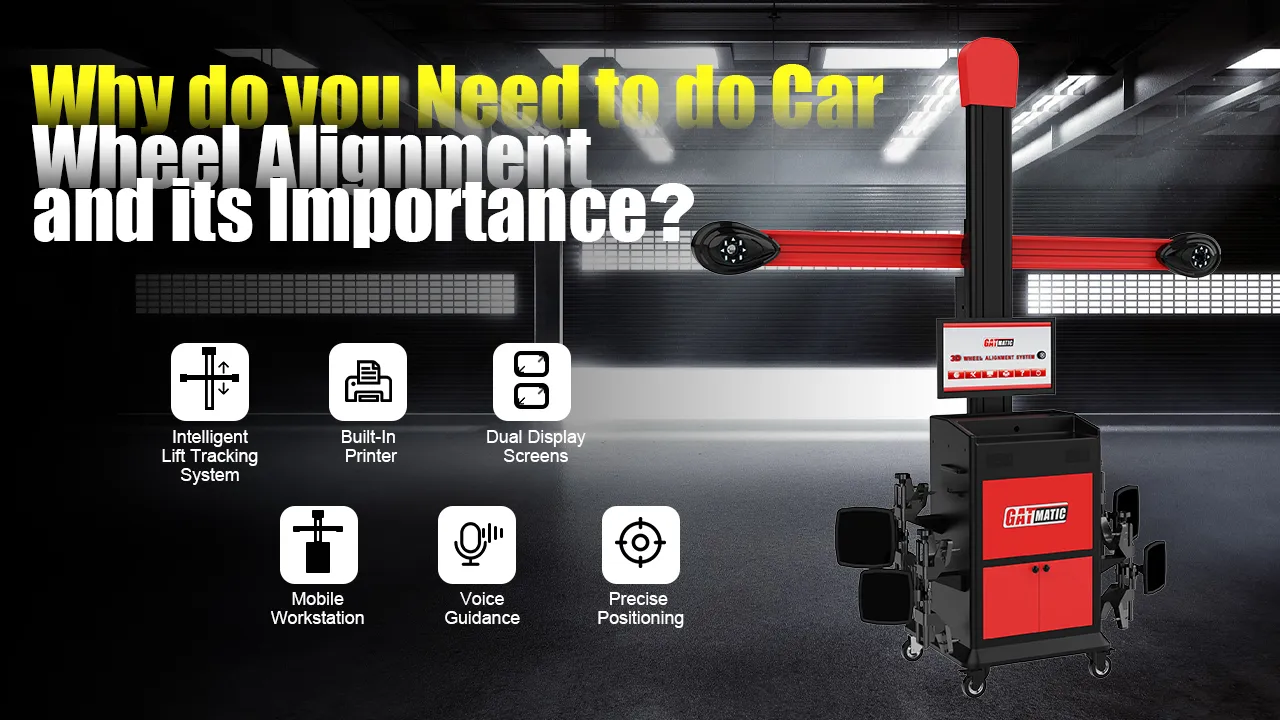Recent Blog
-
Why do you Need to do Car Wheel Alignment and its Importance
2025-08-12 -
Touchless Wheel Alignment: The Future of Auto Maintenance
2025-08-06 -
Why More Auto Repair Shops are adding Injector Cleaner and Tester in 2025
2025-07-29 -
Understanding the Key Features of an Automotive AC Recovery Machine
2025-07-24
Why do you Need to do Car Wheel Alignment and its Importance
Introduction:
Many drivers underestimate the importance of wheel alignment, often waiting until noticeable problems arise, such as uneven tire wear or steering wheel slippage. Regular maintenance checks, such as tire balancing and alignment, are essential for a smooth driving experience and long tire life. Neglecting wheel alignment can lead to costly repairs and even endanger road safety. In this article, we’ll explore what car wheel alignment is, its importance, and how it differs from tire balancing.
When an automotive technician performs a wheel alignment, they adjust three key angles to help achieve optimal vehicle performance: caster, toe, and camber.
-
Caster: This is the forward or backward tilt of the steering axis when viewed from the side of the vehicle, affecting balance and steering stability.
-
Toe: This refers to the orientation of the tires relative to each other when viewed from above, affecting the uniformity of tire wear.
-
Camber: This is the inward or outward tilt of the tires when viewed from the front, which is crucial for maintaining grip when cornering.
Two-Wheel Alignment
A two-wheel alignment, often called a front-wheel alignment, focuses on adjusting the angle of the front wheels. This is most common on vehicles with only front-wheel steering. However, if your vehicle has rear-wheel steering, or if an inspection reveals a problem with the rear wheel alignment (despite the front wheels being correctly aligned), your technician may perform a rear-wheel alignment. This specialized adjustment is similar to a front-wheel alignment but is customized to the unique setup of the rear wheels.
Four-Wheel Alignment
-
Vehicle Positioning: The vehicle to be measured is placed onto an alignment stand or lift.
-
Mounting Targets: Specialized wheel clamps and targets are installed on each wheel, which are lightweight and easy to handle.
-
Image Capture: A high-resolution camera scans the targets, capturing the precise three-dimensional position of each wheel.
-
Vehicle Adjustment: Following the on-screen instructions, the vehicle’s forward and backward roll adjustment and steering wheel rotation are performed.
-
Data Analysis: The 3D wheel aligner software compares the readings with the manufacturer’s specifications, instantly detecting deviations in camber, caster, and toe angles.
-
Adjustment: Based on the resulting data, the technician adjusts suspension components, such as tie rods and control arms, to achieve correct alignment for all four wheels.
-
Final Verification
Improve vehicle safety
Misaligned wheels can cause unstable handling, especially during emergency maneuvers or braking. Proper tire alignment and balancing help ensure a smooth running vehicle, preventing vibrations and shakes that can affect driving comfort and safety.
Reduce wear on suspension components
Suspension components wear naturally over time or can become misaligned due to collisions with potholes, curbs, or minor accidents. Proper wheel alignment distributes weight evenly, reducing stress on suspension and steering components.
Extend tire life
This type of misalignment can cause uneven tire wear because specific areas of the tire are subjected to uneven pressure. This uneven wear shortens the life of the tire and can compromise vehicle safety, leading to premature tire replacement. Proper wheel alignment prevents uneven wear and allows the tire to reach its intended lifespan.
Improve fuel efficiency
Driving on unevenly worn tires can result in poor handling and make it more difficult to maintain your intended driving line. Uneven tire wear increases resistance between the tires and the road. This resistance forces the vehicle to expend more energy to maintain speed, increasing overall fuel consumption. Therefore, if wheel alignment is neglected, drivers may end up driving a less fuel-efficient vehicle.
Improve driving comfort
Additionally, unevenly worn tires can create steering wheel vibrations and increase road noise, further degrading the driving experience. A well-aligned car tracks straight without sidling, reducing driver fatigue and improving comfort.
wheel alignment
Wheel alignment involves adjusting the wheel angles, such as camber, caster, and toe, to meet the manufacturer’s specifications. Proper alignment helps ensure straight driving and optimal tire-to-road contact, which helps improve handling and extend tire life.
Tire balancing
Tire balancing helps ensure even weight distribution across the wheels, reducing vibration and uneven wear through precise machine adjustment. This procedure can eliminate steering wheel or seat vibrations, especially at certain speeds. Regular balancing is recommended after tire rotations, repairs, or during scheduled maintenance.
Q: How often should I get my car wheel alignment done?
A: Most experts recommend checking alignment every 10,000–12,000 kilometers or once a year. However, if you frequently drive on rough roads or hit potholes, more frequent checks are advised.
Q: What are the signs my car needs wheel alignment?
A: Common symptoms include the car pulling to one side, uneven or rapid tire wear, a crooked steering wheel, and squealing tires during turns.
Q: Can misalignment cause vibrations?
A: Misalignment usually causes pulling and uneven wear, but vibrations are typically linked to wheel balancing issues or damaged suspension components.
Q: Is four-wheel alignment worth it?
Describe Your Needs In Detail!
We will carefully evaluate your needs and give professional solutions.



